Safety Tips for Traveling with Dogs in Your Car: Essential Guidelines for a Secure Journey
Traveling with dogs can be an enjoyable experience for pet owners who want to include their furry companions in their road trip adventures. However, it’s important to prioritize pet safety to ensure a smooth and stress-free journey for both you and your dog. Whether you’re going for a short drive to the park or embarking on a long-distance road trip, proper planning and safety measures are essential.
Considering the unpredictability of animal behavior and the unique requirements of each dog, car travel with pets necessitates special attention. Securing your pet, managing their comfort, and being prepared for emergencies are just a few aspects of creating a safe traveling environment. Knowing how to properly restrain your dog in the vehicle, providing adequate ventilation, and ensuring regular breaks for exercise and bathroom needs are vital components of safe car travel with your dog.
By adhering to safety protocols and preparing for various travel scenarios, you can minimize risks and potential distractions. This keeps you, your dog, and other road users safe. Remember, a secure dog is a safe co-pilot, and investing in your pet’s safety can lead to a pleasurable driving experience for everyone involved.
Preparing Your Dog for Car Travel
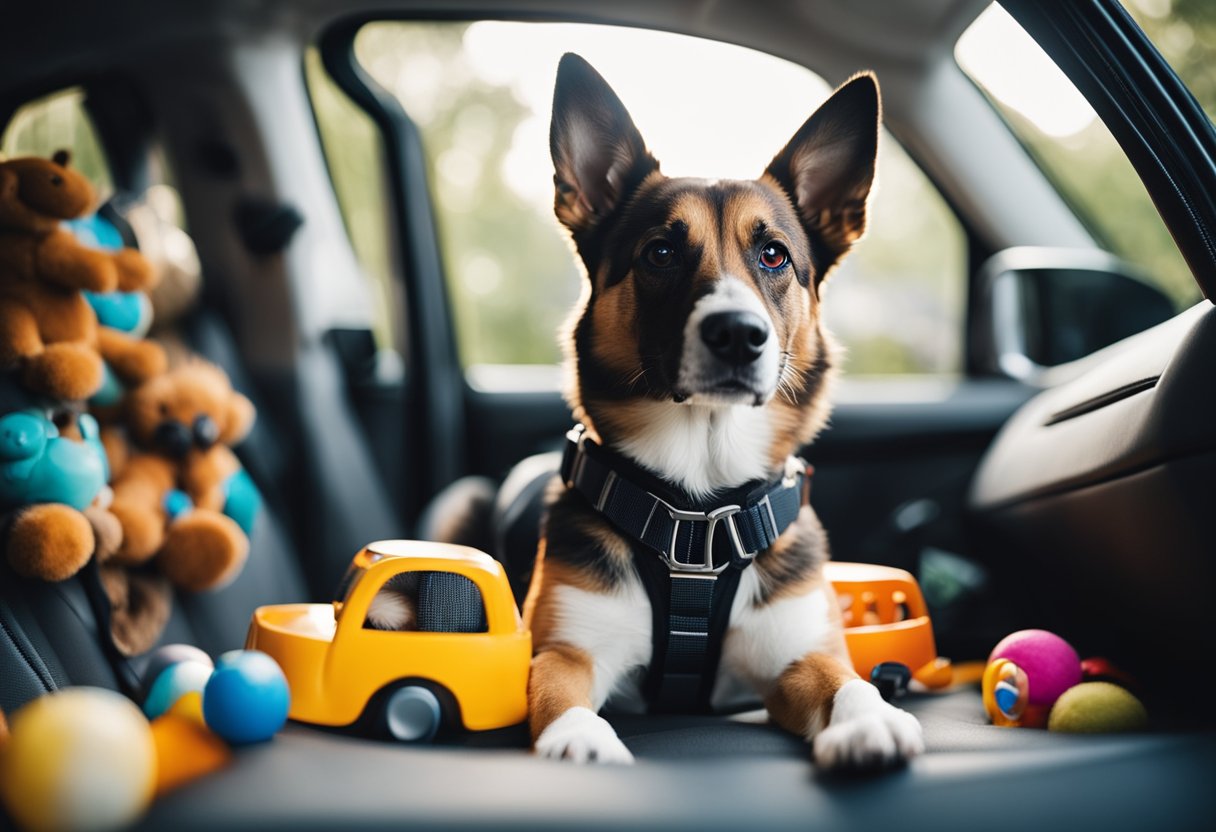
Before embarking on a road trip with your canine companion, it’s crucial to prepare them for the experience. Training for behavior adapted to car rides and confirming their health and safety are essential steps.
Behavior and Training Essentials
Introduction to the Vehicle:
Start by introducing your dog to the vehicle in a stationary state. Allow them to become comfortable by:
- Sitting in the parked car with you
- Progressing to engine idling
- Finally, taking short drives
Basic Commands and Manners:
Ensurе your dog understands basic commands such as sit, stay, and come. This helps:
- Maintain control during the travel
- Prevent distractions while you’re driving
Desensitization:
- Gradually increase travel time to decrease anxiety
- Pair travels with positive experiences like treats or park visits
Safety Equipment:
- Use a crash-tested harness or travel crate
- Ensure they’re properly fitted and secure
Health and Safety Checks
Vet Checkup and Vaccinations:
- Schedule a checkup before long trips to ensure your dog is fit for travel
- Confirm all vaccinations are up to date, and carry the rabies and vaccination certificates
Identification and Health Certificates:
- Verify that identification tags are secure on your dog’s collar
- A health certificate may be required for interstate travel; consult your veterinarian
Medications and Emergency Kits:
- Pack any medications your dog requires
- Include a first aid kit for emergencies
Leash and Collar:
- Always have a leash ready for rest stops
- The collar should fit well and not pose a choking hazard
By adhering to these specific guidelines, you can ensure a safer and more comfortable car travel experience for your dog.
Choosing the Right Restraints and Gear
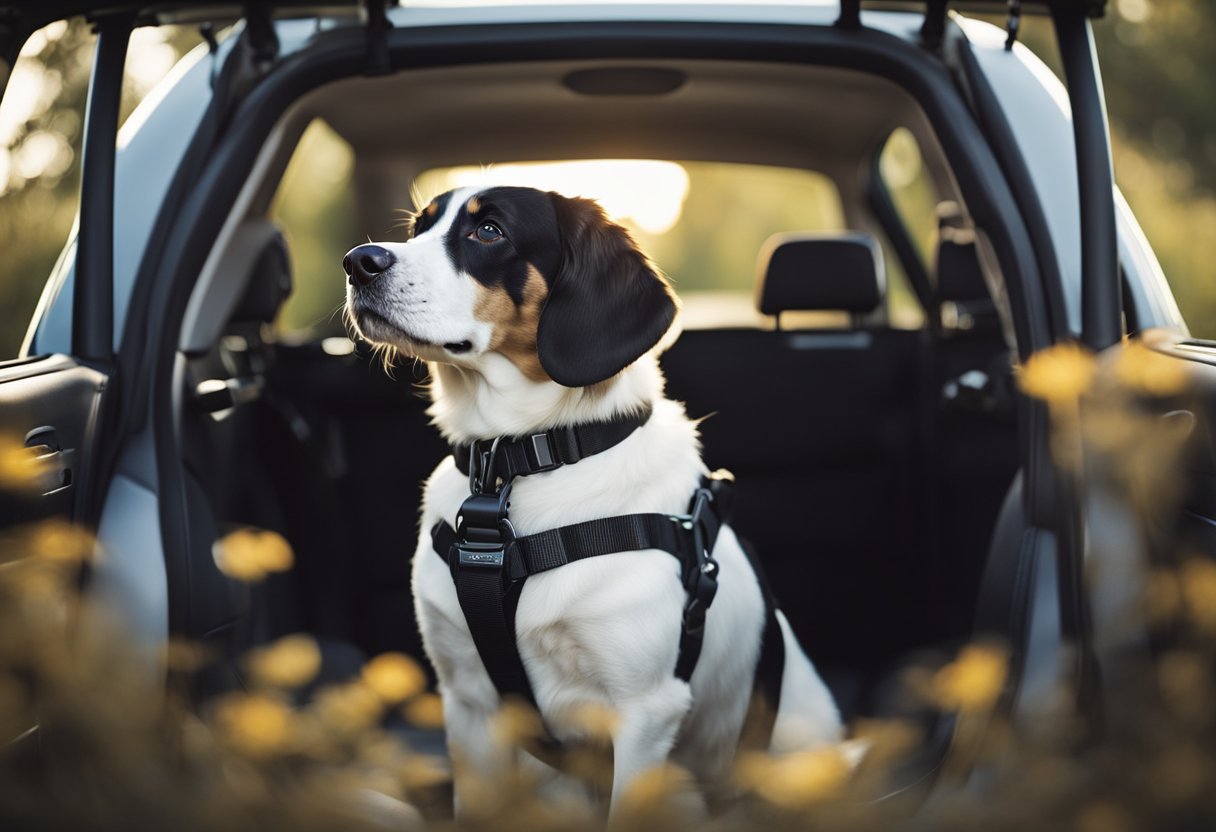
Selecting suitable restraints and gear for your dog’s car travel is crucial for their safety and your peace of mind. Prioritize certified equipment that’s been tested for durability and safety.
Harnesses and Dog Seat Belts
When driving with your dog, it’s essential to ensure they are properly restrained. A harness designed for car travel is a safer option compared to a standard walking harness. Look for products with a strong track record of safety, such as those tested by the Center for Pet Safety.
- Materials: Durable, breathable fabric
- Fit: Adjustable for a snug fit; follow the manufacturer’s size chart
- Certification: Look for crash-tested marks
- Connection: Securely attaches to the car’s seat belts
Remember, placing your dog in the front seat is not advised as the airbag can pose a risk in the event of an accident.
Crates and Carriers
Crates and Carriers offer another secure method to transport your dog. To maximize pet safety, choose a carrier that provides ample space for your dog to sit, stand, and turn around comfortably.
- Material: High-impact materials for durability
- Size: Appropriate to your dog’s size (length and height)
- Ventilation: Ample air flow for comfort
- Attachment: Properly anchor the crate inside your vehicle
Position the crate in a stable area of the car, avoiding direct contact with airbags. Secure the crate to prevent shifting, using straps or the vehicle’s cargo hooks.
Car Safety Protocols
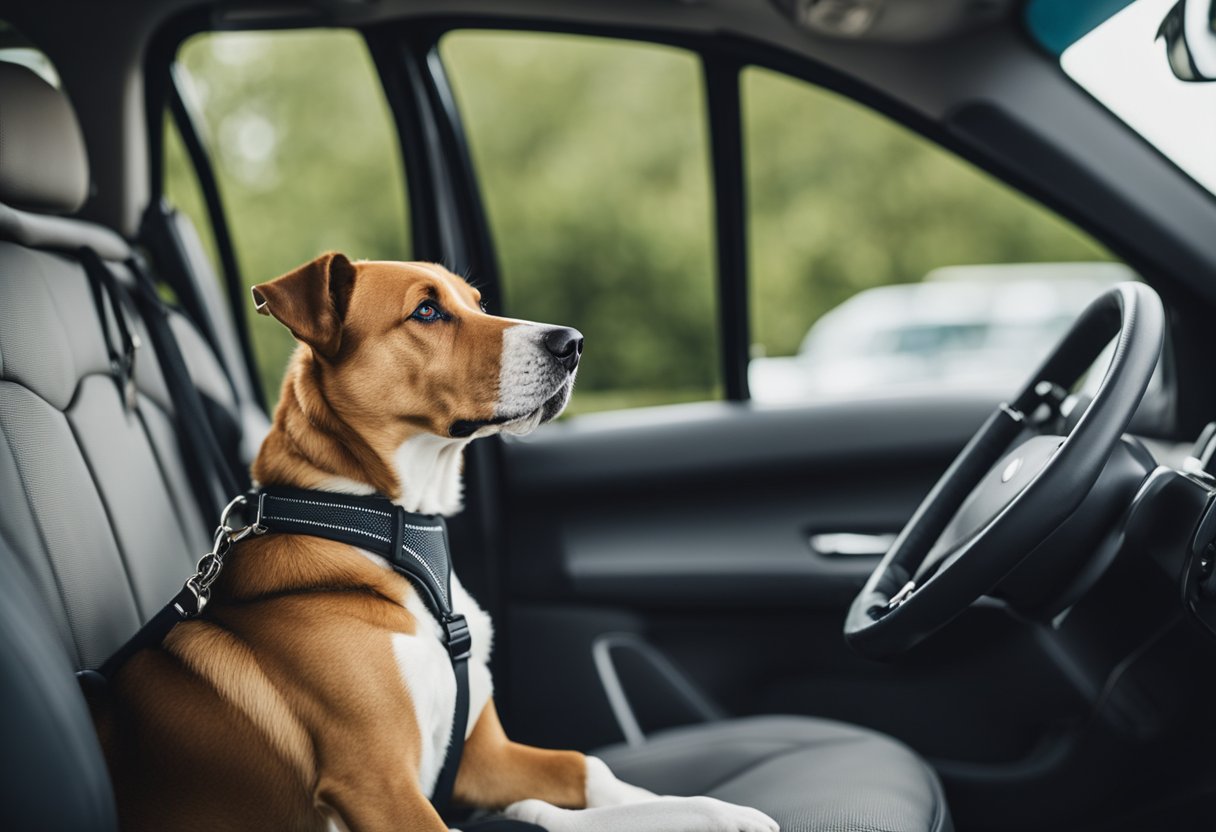
When traveling with your dog in your car, it’s essential to maintain proper ventilation and temperature control to prevent heatstroke and motion sickness. Always have bottled water accessible to keep your dog hydrated.
Window and Ventilation Control
To ensure your dog’s safety, never leave them alone in a car with the windows completely closed. Sufficient airflow is vital to avoid overheating, which can lead to heat stroke. Adjust your car’s windows to allow fresh air in while ensuring your dog cannot escape or put their head out, which could result in injury. Use window guards or screens if necessary.
Managing Temperature and Hydration
Keep your car’s interior at a comfortable temperature, especially during warmer seasons. Avoid extreme temperatures; using air conditioning or heat can help maintain a safe environment. Ensure your dog has constant access to water; a spill-proof bowl filled with water is ideal for longer trips. Remember to pack enough bottled water for both you and your dog.
- Temperature: Comfortable (not too hot/cold)
- Hydration: Water available at all times
Preventing Motion Sickness
Carsickness can be distressing for your dog. To prevent it, feed your dog a few hours before the trip and avoid heavy meals during the journey. If your dog is prone to motion sickness, consult your veterinarian for possible solutions or medications. Keep the ride smooth and steady to reduce the chance of carsickness.
- Feeding: Light meal few hours prior to travel
- Ride: Smooth to minimize sickness
On the Road: Practical Tips and Considerations
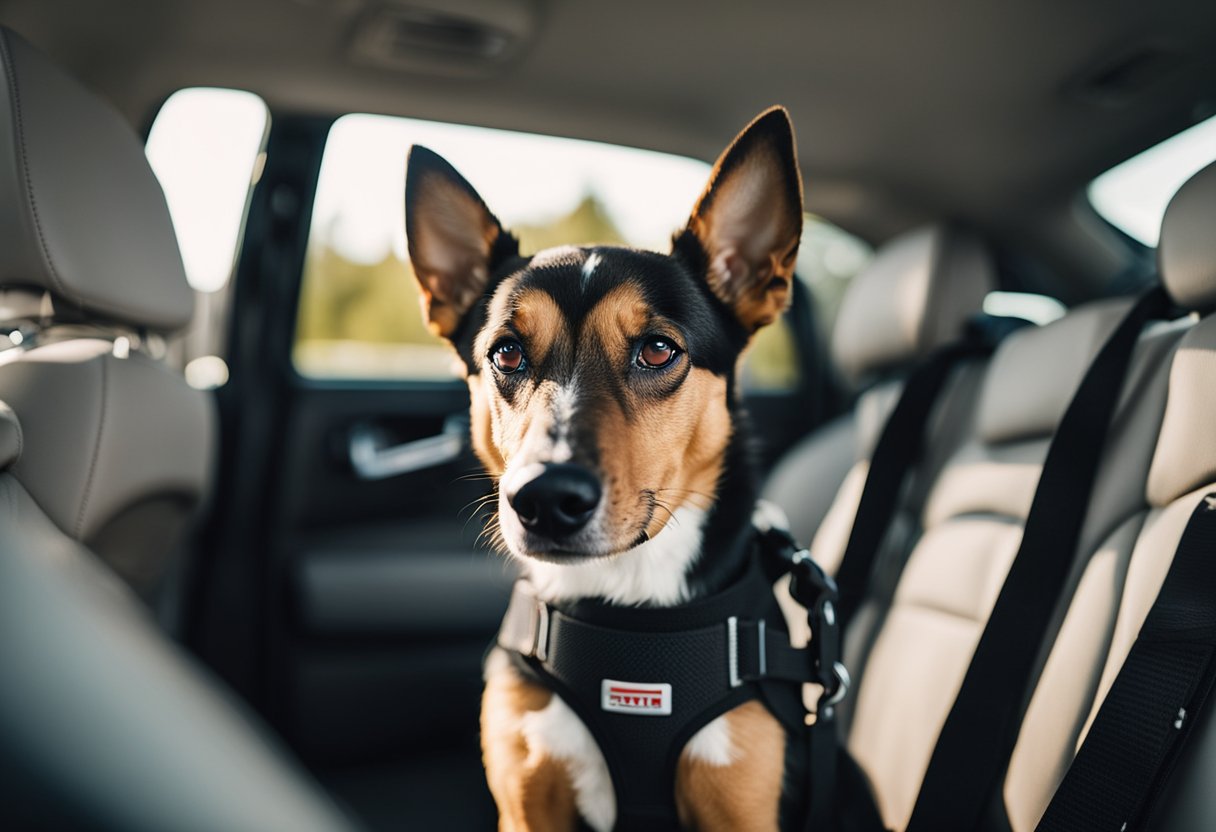
When traveling with your dog in the car, it’s important to make the journey comfortable and safe for both you and your pet. Plan for regular stops and know how to handle their needs and any potential emergencies.
Rest Stops and Exercise
Make regular rest stops, ideally every 2-3 hours, to let your dog stretch its legs and relieve itself. Look for pet-friendly parks or rest areas with space for dogs to walk. Always use a leash during exercise to ensure safety.
- Supplies for Exercise:
- Leash and collar/harness
- Favorite toys to keep them engaged
- Water bowl, possibly a collapsible type to save space
Feeding and Treat Management
Mind your dog’s feeding schedule and try to stick to the routine to avoid stomach upset. Use a collapsible water bowl for easy storage and access. Offer biscuits and treats judiciously to avoid overfeeding.
- Feeding Schedule:
- Regular feeding time
- Limited quantity of food and treats on the move
Handling Emergencies
Prepare an emergency kit in case of any incident and know the location of the nearest vet to any rest stop or park you visit. Include the following in your kit:
- Emergency Kit Contents:
- First aid supplies
- Contact details of emergency services and nearby veterinarians
- Extra leash and collar
Remember to keep your dog’s emergency kit easily accessible at all times. Stay calm during emergencies, and seek professional help as soon as possible.
Accommodations and Overnight Stays
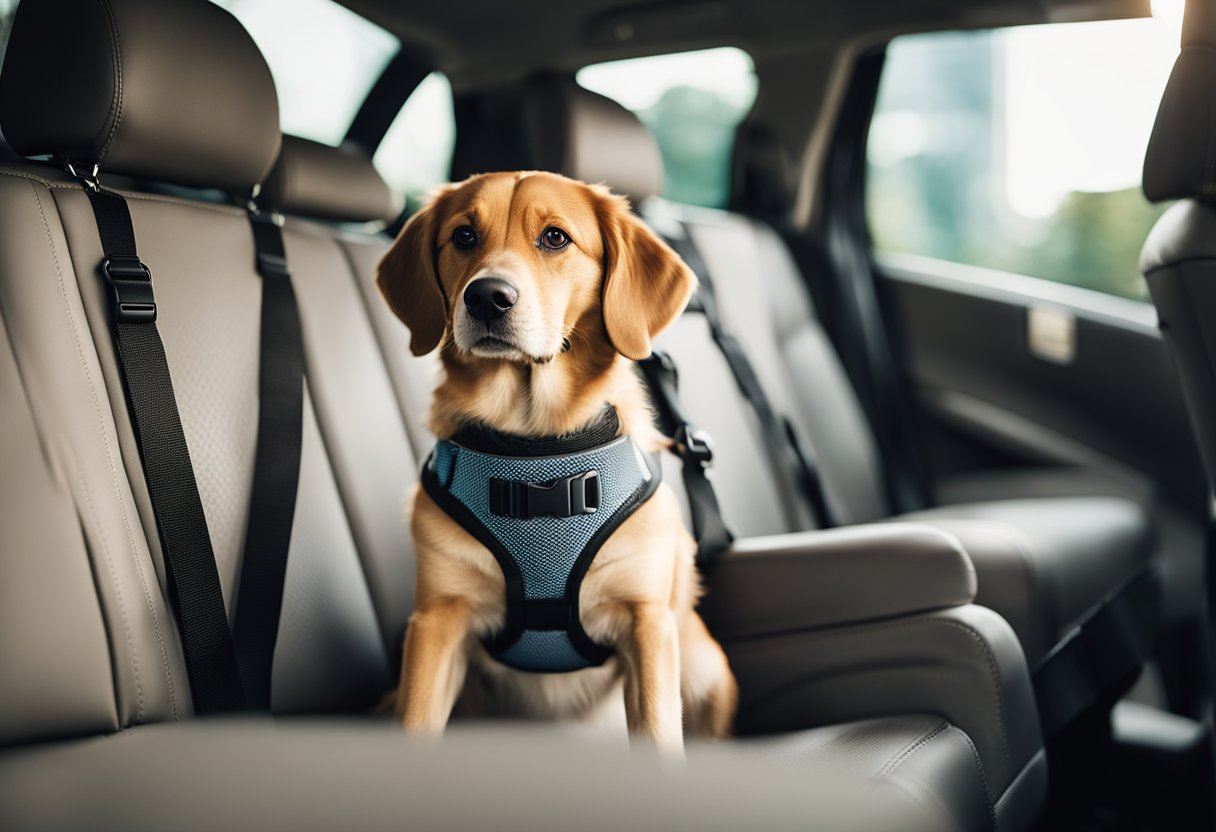
When traveling with your dog, choosing pet-friendly accommodations is essential for their safety and comfort. Ensure that the hotels or lodgings you pick welcome pets and provide suitable amenities for your four-legged companion.
Finding Pet-Friendly Lodging
You’ll want to confirm that your intended overnight stay is at a pet-friendly establishment. Here’s how you can do that:
- Research: Use travel websites and apps that specifically filter for pet-friendly hotels and lodging options.
- Read Policies: Check the hotel’s pet policy for any weight or breed restrictions, additional fees, and available amenities.
- Call Ahead: A quick phone call can clarify any uncertainties about the pet policy and secure a reservation in a pet-friendly room.
Be mindful of nearby pet supply stores in case you need to pick up any essentials during your stay.
Overnight Safety and Comfort
For a restful night, consider the following tips to ensure your dog’s safety and comfort:
- Crate or Restraint: Use a dog crate or restraint to prevent injuries from sudden stops or turns.
- Familiar Bedding: Bring your dog’s bed or a favorite blanket to help them feel secure and at home.
- Quiet Area: Request a room away from high-traffic areas to reduce stress and noise.
- Routine Walks: Maintain your dog’s routine with regular walks to manage stress and expend energy.
- Emergency Info: Have the contact information of a nearby veterinarian handy in case of an emergency.
Remember to never leave your dog alone in the room unless the hotel policy allows it, and ensure they are always wearing identification.
Other Modes of Pet Travel
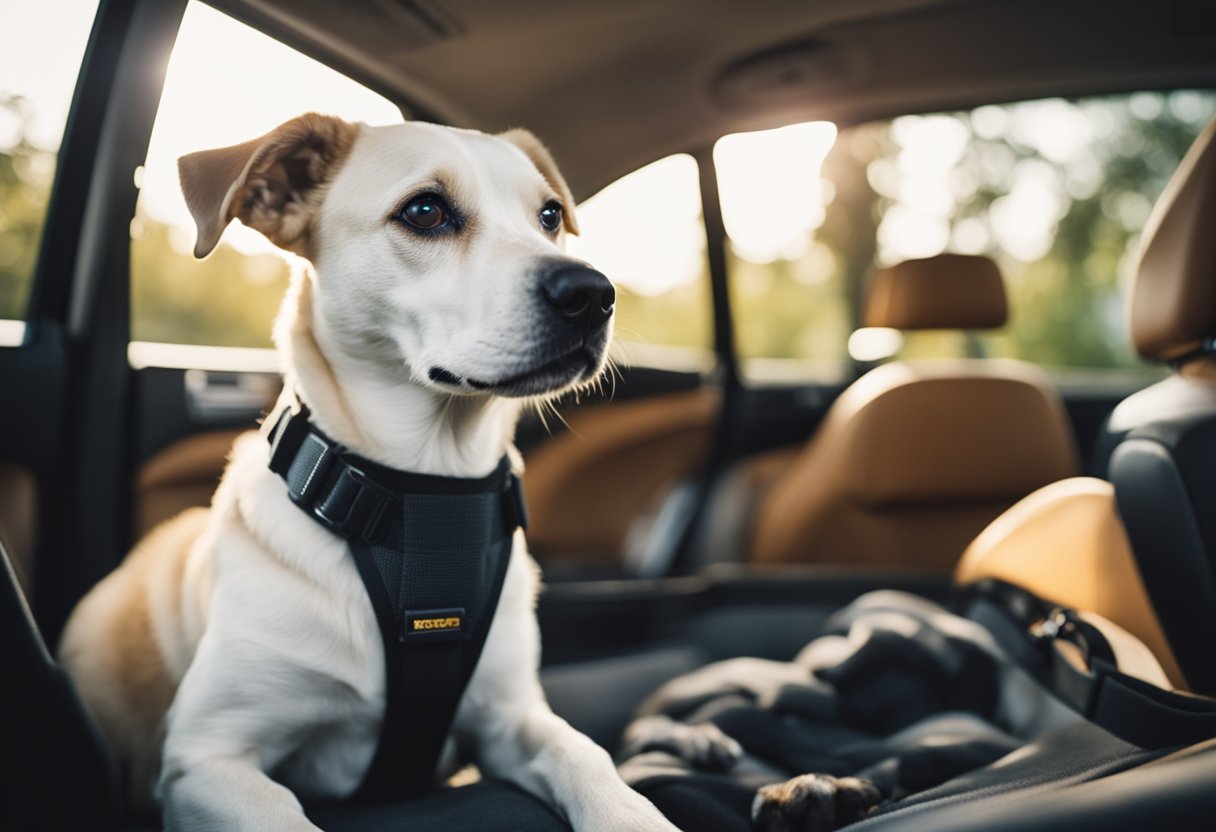
When driving isn’t an option or you’re looking for alternate ways to transport your dog, air travel and other transportation methods can be viable options. Each comes with unique requirements and considerations to ensure the safety and comfort of your pet.
Traveling with Dogs by Air
- Preparation: Confirm with airlines for pet-specific guidelines.
- Flights: Opt for a direct flight to lessen stress on your dog.
- Health Certification: Acquire a health certificate, typically within 10 days of travel.
- Crate: Ensure an IATA-compliant crate with proper identification.
Flying with dogs calls for thorough preparation. First, confirm the airline’s pet policies as they vary widely; some airlines restrict dog breeds, especially brachycephalic (short-nosed) breeds, due to health risks. Booking a direct flight can markedly reduce the stress endured by your pet and the risk of long layovers or mishandling by cargo personnel.
Before flying, a health certificate from your vet is usually required, and it’s often mandatory for the certificate to be dated within 10 days of your trip. Additionally, have your dog microchipped and the crate labeled with your contact info to increase the safety and traceability of your dog.
Additional Transport Options
- Trains: Check policies; some allow dogs, often with size restrictions.
- Boats: Ensure dogs are allowed and inquire about safety measures.
- Buses: Service dogs are typically allowed; pets depend on the bus line’s policy.
Beyond cars and planes, trains, boats, and buses may accommodate your dog. Train travel often permits dogs, but usually imposes size restrictions and requires them to be in a crate or on a leash at all times. Confirm with train operators for detailed policies.
Boat travel with dogs varies greatly depending on the ferry or cruise line. Always check beforehand about the possibility and conditions of having your dog onboard. For bus travel, service dogs are generally allowed, but other pets depend on the policy of the bus line. Buses may be more restrictive, so be sure to check well in advance of your trip.
Regulations and Documentation
When traveling with your dog in the car, it’s essential to comply with the regulations and carry the necessary documentation to ensure a smooth journey for both you and your pet.
Certification and Identification
Your dog should have a current ID tag attached to its collar, displaying your contact information. This is crucial in case your pet gets lost during your travels. Additionally, it’s often a legal requirement to carry a certification of health from a veterinarian, especially when crossing state lines or traveling to another country. This certification should be up-to-date and may need to display proof of vaccinations. For added security and traceability, consider having your dog microchipped if it isn’t already.
Service and Assistance Dogs
Service and assistance dogs may be subject to specific regulations that differ from pets. Always carry proof of certification for your service dog, as this helps verify their status and training in situations where it’s required. The documentation should clearly state that your dog is a service or assistance animal to ensure access to facilities where pets might not usually be allowed. Note that service dogs are also commonly microchipped and must wear their ID tags at all times.
Frequently Asked Questions
When traveling by car with your dog, safety is paramount, and comfort can greatly enhance the experience for your pet. The following frequently asked questions will guide you in ensuring a secure and pleasant journey for both of you.
What is the safest method to secure my dog while driving?
For maximum safety, secure your dog with a crash-tested harness or in a travel crate that is anchored to the vehicle. Make sure the harness fits well and the crate is large enough for your dog to stand, turn around, and lie down comfortably.
What are essential items to pack for a dog when planning a long car journey?
Bring sufficient food, water, a water bowl, a leash, waste bags, and a familiar blanket or toy to help your dog feel at ease. Don’t forget any necessary medications and a dog first-aid kit.
How can I make long-distance car travel comfortable for my dog?
Ensure your dog has a comfortable space with a non-slip surface. Maintain a comfortable temperature in the car and consider using sunshades for the windows. Stop regularly for bathroom breaks and to allow your dog to stretch and exercise.
What are effective ways to keep a dog calm during car rides?
Gradually acclimate your dog to the car by starting with short trips and slowly increasing the duration. Safe and well-fitted travel gear can also aid in calming your pet. Sometimes, soothing music or chew toys can help reduce anxiety.
For how many hours is it safe for a dog to travel in a car without breaks?
Typically, dogs should not travel more than 2-3 hours without a break to relieve themselves, hydrate, and stretch their legs. Younger, older, or dogs with health issues may need more frequent stops.
Is it permissible for a dog to ride in the passenger seat, and if so, what precautions should be taken?
A dog can ride in the passenger seat if necessary safety precautions are in place. Use a crash-tested dog seatbelt and make sure the airbag is turned off, as it can harm your dog in the event of an accident. Always secure your dog, so they don’t distract the driver.

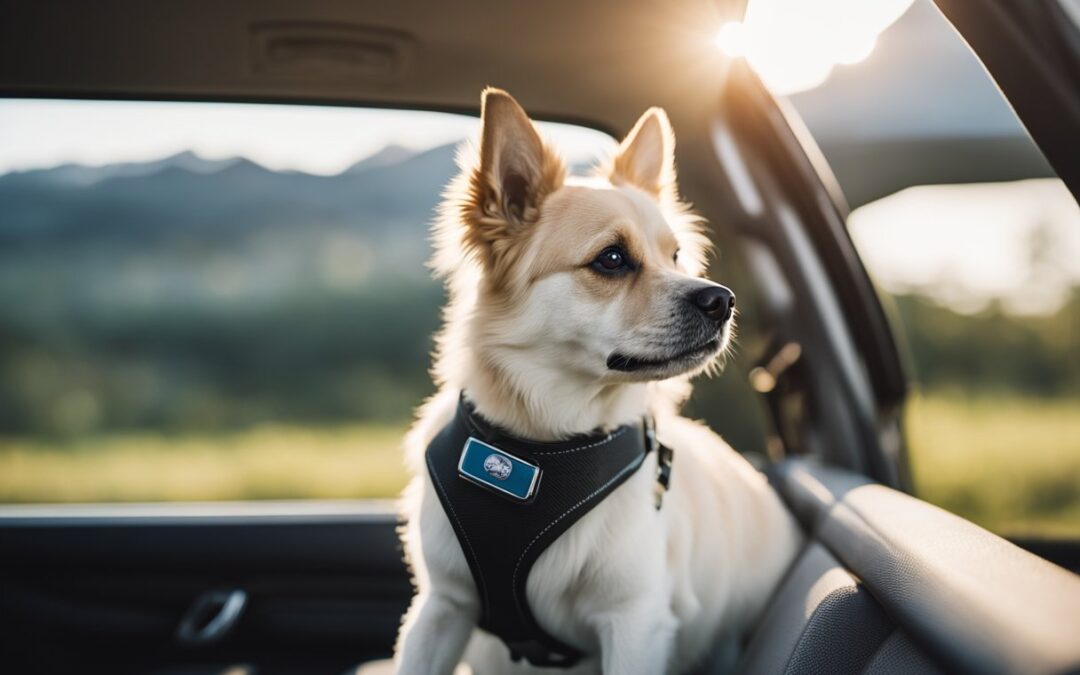

Recent Comments